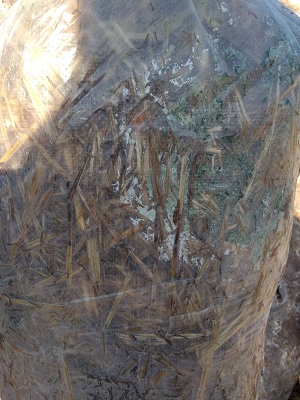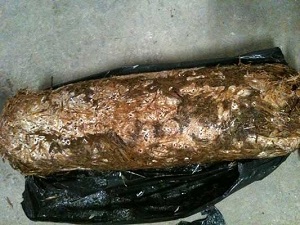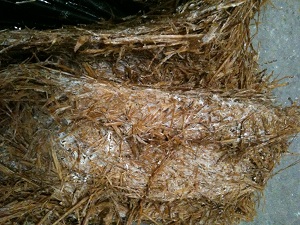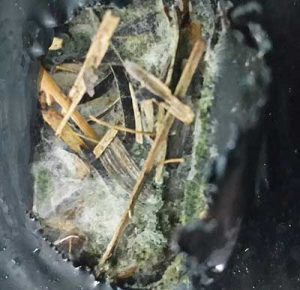
Green mold Trichoderma is the most common reason why mushroom growers have spoiled mycelium.
How to determine whether mold or mycelium is growing in a block?
At the beginning of overgrowing of the mycelium, this mold is not visible.
The first days it develops along with the oyster mushroom mycelium. Its hyphae are pale white and very difficult to distinguish from oyster mushroom mycelium.
When trichoderma is ripe, its spores appear in large numbers.
Here they are, and have a green color of various shades.
Methods such as covering mold stains with various solutions do not give good results.
Articles on the Internet offer different solutions and their mixtures containing table salt, hydrogen peroxide, sodium hypochlorite and lime.
Of course, they are not suggesting mixing it all together. I just listed the substances that are mixed most often. For example - salt with lime or sodium hypochlorite with lime.
You can apply this solution to one small spot inside the substrate if it is under the film.
However, if there is only one spot and it is small, the oyster mushroom mycelium will handle it itself.
And if the entire substrate is stained like this, you will not kill the mold with this solution.
Can mycelium fight off green mold?
I already wrote above that if the Trichoderma spot is small, the size of an apple or orange, the oyster mushroom mycelium can grow into this place after the Trichoderma throws out its green spores.
The hyphae of oyster mushroom mycelium secrete substances that kill mold hyphae.
However, if there is a lot of mold, the mycelium cannot kill it.
Mold does not grow if the substrate has an alkaline pH.
This is discussed in detail below in the article.
Trichoderma is a fairly common mold that lives in the soil. It plays an important role in processes that enrich the soil with nutrients.
Therefore, its spores are present everywhere in moderate quantities.
At a mushroom enterprise, the concentration of spores is higher, since there are conditions for the development of Trichoderma.
To prevent mold spores from becoming your problem, follow these rules:
- Be sure to do preventive disinfection of premises (a link to an article about this is at the bottom of this article).
- Dispose of used substrate correctly.
- Follow the substrate production flow chart. It is important to observe the temperature regime, processing time and sowing regulations necessary for your chosen method (pasteurization, sterilization, hot water treatment)
To get rid of the problem with trichoderma, you need to know its cause.
There are three main reasons, I will list them, starting from the most common:
Violation of the regulations in any technology:
 Often there is not one, but two, and even all three violations.
Often there is not one, but two, and even all three violations.
Green mold in this case is settled throughout the thickness of the substrate.
Sometimes the mycelium cannot begin to grow at all, and the oyster mushroom mycelium grains are covered with a gray-green coating.
As a rule, the quality of the mycelium has nothing to do with it - it's just that, first of all, the mold begins to occupy the boiled grain, since there is a lot of easily digestible nutrition there.
And later, the hyphae of Trichoderma passes to the husk or straw that is poorer in nitrogen.
How to control green mould in mushroom substrate:
Infection is observed only under the film.
If there are temperature fluctuations in the incubator or you cool the substrate abruptly with cold air, you have a large temperature difference between the underfilm layer and the center of the substrate in the bag. This causes an outflow of water from the center to the film.
The presence of free water between the polyethylene and the substrate leads to increased growth of mold and/or bacteria.
Although when breaking it is clear that the entire thickness of the substrate is overgrown evenly, beautifully and does not contain the inclusion of trichoderma anywhere except the surface layer, such batches practically do not bear fruit.


How to fix
In this case, the mold is located only in the perforations. Inside, under the film, the entire mass in the bag is well overgrown, white.

This suggests that the mold has settled in the room itself, and its spores sit in the perforation and germinate.
Most often, this mold is Trichoderma, but there are lesions with gray and black spores.
These are different types of mold, but you don't need to know their name, as the method of getting rid of them does not depend on the type of mold.
In case of single lesions, you can remove part of the straw (husk) from the cut by hand, treat the hole with a rag with 5% hydrogen peroxide or sodium hypochlorite solution (use gloves, please!) and seal the hole with tape.
If almost all openings have mold, this indicates a high level of mold infestation in the room.
They are not visible to the naked eye. But if you sow the air on a Petri dish, on the third or fourth day it becomes overgrown with multi-colored colonies.
It is necessary to empty the incubator and treat it with sporicidal disinfectants or fungicides.
Read about other types of mold on growing mycelium here
